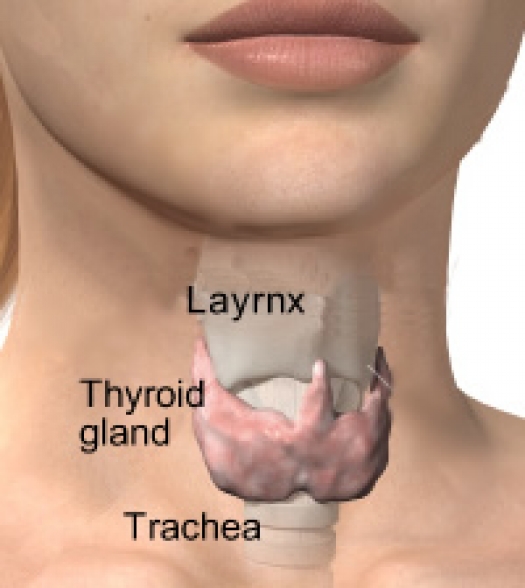Lecture by Dr. Noseworthy, Apex Energetics
- Location: Webinar
- Date: November 11, 2009
- Attendee: Joanne Quinn, PhD, RMA
thyroidgland.jpg

Stock photo
The thyroid gland is found in the neck just below the "Adam's apple." It is responsible for producing thyroid hormone which stimulates the metabolism of the body.
The Foundation for Alternative and Integrative Medicine (FAIM) makes it a priority to study the latest in therapies for issues which create chronic and degenerative diseases. One of these imbalances of the body includes autoimmune thyroid, otherwise known as Hashimoto's. Statistics show that almost 80% of all hypothyroidism is actually the autoimmune disease of Hashimoto's. Often times Hashimoto's does not get diagnosed if the practitioner fails to run the proper antibody test.
If the correct diagnosis is determined, then the treatment is actually for immune dysfunction more than thyroid dysfunction. The symptoms of Hashimoto's include a decrease in metabolic rate of all cells, decrease in gastrointestinal motility, decrease in the production of enzymes, various anemias, low hydrochloric acid in the stomach, altered neurotransmitter expression, decreased lipolysis, decrease in Phase II hepatic clearance, increased progesterone receptor site sensitivity and increase in the production of Sex-Hormone-Binding-Globulin.
Decreased thyroid activity can have many causes including anterior pituitary hypofunction, nutrient deficiency, thyroid resistance where the receptors don't respond, under conversion of T4 to T3, over conversion of T3 leading to thyroid resistance, increased thyroid-binding proteins from chronic stress, and finally from autoimmune issues such as Hashimoto's. With autoimmune disorders affecting the thyroid, it can express itself as Grave's disease when the thyroid becomes hyperactive. In this case there is not an attack on the thyroid tissue but rather an actuation of the TSH receptors, increasing the production of T4 and ultimately T3. The other autoimmune disorder is called Hashimoto's which can express itself as hyperactive or hypoactive thyroid. In this case the thyroid tissue is attacked by the immune system, begins as Hashimoto's thyroiditis (hyperthyroid) and then in later stages of the disease the thyroid becomes hypoactive. In Dr. Noseworthy's practice he sees 300 Hashimoto's cases to every one case of Grave's disease.
So what is the process involved in Hashimoto's? First the individual must have a predisposition genetically to be susceptible. Then, after an environmental trigger, there is phenotypic expression. There is a loss of thyroid tissue, lowering the thyroid hormone production and stimulating Thyroid Stimulating Hormone (TSH). Typically hypothyroidism is diagnosed. A discerning practitioner would then run an additional test to look for thyroid peroxidase antibodies (TPO ab), thyroglobulin antibodies (TGB ab) and thyroid stimulating hormone antibodies (TSH ab). If the TSH ab is the only one elevated then a diagnosis of Grave's is typical. If the TPO ab and/or TGB ab are elevated a diagnosis of Hashimoto's is typical.
The symptoms which help separate Hashimoto's from hypothyroidism include mixed symptoms of hyperthyroid and hypothyroid, non-responsiveness to thyroid medication, elevated TSH and consistent need to increase thyroid hormones to get response.
In order to understand Hashimoto's it is necessary to understand the immune system and what is happening with an autoimmune response. The immune system has many feedback loops to help keep it in control. When there is an invader or perceived invader the T Helper cells are summoned. These cells call out to the NK killer cells and cytotoxic T cells which are a part of the TH-1 side of the immune system. These are kept in check by regulatory T cells which stimulate T suppressor cells once the immune response is no longer needed. The other side of the immune system is called the TH-2 side. B cells which produce antibodies are included here. In the case of autoimmune disease either the TH-1 or the TH-2 side of the immune system gets flared up. In Hashimoto's it is more common for the TH-1 side to be dominant, but sometimes the TH-2 side becomes dominant. These two sides operate much like a see-saw. If one is overactive, the other is often suppressed.
In order to effectively treat an autoimmune disease such as Hashimoto's it is necessary to treat the autoimmune dysfunction. There are known substances which support both the TH-1 and TH-2 sides of the immune system. For example, if the TH-1 side is flared up, research shows that pine bark extract, grape seed extract, green tea extract, resveratrol and pycnogenol help achieve balance. If the TH-2 side is flared up research shows that astragalus, Echinacea, glycyrrhiza, Melissa officinalis and maitake mushrooms help restore balance. It is possible, through blood testing, to determine which side of the immune system is over reacting through cytokine testing. In this way, proper nutritional support can be determined.
Another key to successful treatment of Hashimoto's is to determine what triggers have caused the phenotypic expression of the genetic susceptibility. Triggers include gluten intolerance, too much iodine ingestion, pregnancy, perimenopause, heavy metal toxicity, gastrointestinal disorders, polycystic ovarian syndrome, insulin resistance and deficiency of vitamin D to mention a few. The most common trigger mentioned here is gluten intolerance which is an intolerance of the gluten in wheat and flour products. There are genetic markers for gluten intolerance which will get turned on if wheat is consumed. Statistics indicate that 83% of the population in the United States carries at least one of the possible genetic markers. In almost all cases of Hashimoto's the individual carries this genetic marker and so it is always suggested that people who have been diagnosed with Hashimoto's remove all gluten products from their diet. In addition, many studies from around the world found that too much iodine and too little iodine can turn on the genetic susceptibility for Hashimoto's. As a result, typical thyroid support for a Hashimoto's patients usually is free of iodine. In the cases of pregnancy and perimenopause, it is the estrogen surges which exacerbate Hashimoto's and often give the same symptoms of menopause including hot flashes, insomnia and irritability. The patient's symptoms are treated as a hormone imbalance when actually they are the result of Hashimoto's. Gastrointestinal issues can trigger the Hashimoto's immune response as well.
Women who suffer with polycystic ovarian syndrome (PCOS) have Hashimoto's 42% of the time. PCOS sufferers battle with insulin resistance and insulin surges which trigger Hashimoto's. Insulin surges cause an inflammatory cascade of cytokines which flare the immune response. With the rise in insulin resistance (IR) in the United States population this can have a very real impact on the number of people susceptible to Hashimoto's. Insulin resistance (high blood sugar) symptoms include fatigue after meals, craving sugar after meals and difficulty falling asleep. Nutritional support for this includes sugar stabilizers and adrenal support. Of course diet and exercise play a key role, as well. Insulin surges are also prevalent in people who suffer from the hypoglycemia(low blood sugar). Hypoglycemic symptoms include energy after meals, craving sugar before meals, inability to stay asleep and a crash and craving for sweets between 3 and 5 pm. Nutritional support also addresses sugar stabilizers and adrenal support as well as diet and exercise.
Vitamin D improves the regulatory T cell balance. It is important to check vitamin D through the 25(OH)D blood test. Sufficient levels range between 33-80 mg/ml but in the case of Hashimoto's it is recommended that a high level be maintained as many Hashimoto's patients have vitamin D receptor deficiency.
Generally for treatment, Dr. Noseworthy recommends addressing all fronts necessary. Foremost to supplement with vitamin D, gut support and support for either the TH-1 or TH-2 side of the immune system, whichever one is deficient. Then he recommends detox if toxicity is a trigger, estrogen clearance if estrogen is a trigger and sugar balance if IR or hypoglycemia is playing a role.
Once Hashimoto's is diagnosed, it is irrelevant to check the TSH or the antibodies after that point. The main avenues for testing should include the T cell and B cell panel, and the cytokine panels looking at cytokines including the TH-1 cytokines (IL-2 and TNF alpha) and the TH-2 cytokines (IL-10 and IL-4) to closely watch how the immune system is responding.
Apex Energetics offers webinars to practitioners within their network. To learn more visit the Apex Energetics website.


